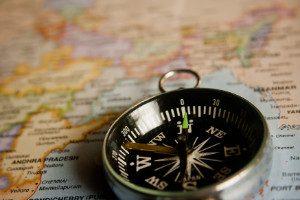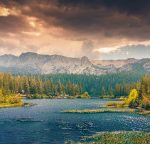Secrets Revealed to Land Navigation for Survival
Secrets Revealed to Land Navigation for Survival
 It is a worst-case scenario for most people.
It is a worst-case scenario for most people.
You have been out hiking all day and decide to leave the trail to check out the view or maybe pick some berries. Before you know it, you have gotten distracted and cannot remember from which direction you came.
You are deep in the forest, and everything looks the same.
You check your cell phone but have no reception or GPS. It will be dark in a few hours, so you start hiking in what you think is the right direction. Soon it appears that you have walked in a circle and are back to the same spot.
It is official… you are lost.
At this point there are several ways that you can potentially navigate yourself to safety. However, they all require some knowledge and preparation.
In this article we will cover how to handle land navigation when you are lost in the wilderness.
Map and Compass
 The absolute best way to navigate in the wild is having a map of the area and a reliable compass.
The absolute best way to navigate in the wild is having a map of the area and a reliable compass.
Used together, you should be able to find your way to safety in any scenario. The map will show you landmarks such as bluffs, valleys, roads, trails, and bodies of water. You can use any of these landmarks to work your way towards civilization.
The compass helps orient the map in the proper direction, so you know which direction you should travel.
To use the map and compass together, first put down your map on a flat surface. Next, place the compass flat on the map next to the compass rose.
This is the image of North, South, East, and West on the map. Once the compass settles, you should be able to see magnetic North. Finally, rotate the map so that North on the map matches North on the compass. You now can tell which direction to hike to find specific landmarks.
You will need to note your cardinal direction of travel and check your compass periodically to maintain your course. For example, if there is a trail Southwest of your location you need to verify that you consistently walk Southwest.
You can use a map or a compass by themselves, but they are not nearly as effective. If you can get to a high point to see in all directions, you might spot a landmark that you can identify on the map. In addition, if you know that your trail was running North to South and you turned right off the trail then you know you need to travel East to get back to your trail.
You can use your compass to find East and travel in that direction. This only works with linear landmarks.
Make a Compass
If you have no compass with you, you are not out of luck.
There are a few ways to figure out which direction is North. One option is a water compass.
Use a cup or anything that will hold some water and fill it up. Set it on a flat spot on the ground. Find something that will float in the middle like a small leaf.
Finally, take a small thin piece of metal such as a needle or straightened paperclip. Rub or strike it with another piece of metal to magnetize it. Then set it on the floating object. Let it settle and you will have your North/South line.
You can also use the sun. Drive a stick into the ground and make a mark where the end of the shadow falls. Wait about 20 minutes and mark the end of that shadow. Draw a line between the two and you have your East/West line.
Draw a perpendicular line for your North/South line.
Follow the Water
 Following a body of water such as a river, stream, or the shoreline of a lake or seashore can be a very effective way to find civilization.
Following a body of water such as a river, stream, or the shoreline of a lake or seashore can be a very effective way to find civilization.
Almost every major city or settlement in the world is built near water. The bigger the body of water, the more likely you are to find people.
If you have no high point in which to spot water, there are a few options. You can head downhill. The lower in elevation you go, the more likely you are to find water. You can read vegetation.
In a dry climate, the only green trees and shrubs you will see will be near water. You can follow the animals. Most animals are creatures of habit. They follow the same trail every day to head to water in the morning and in the evening.
If you follow a game trail, you are likely to find water. Then just head downstream to find larger bodies of water.
Importance of Optics
 You may not think that binoculars would be a survival tool, but in this scenario, they are. It is vital that you be able to find your landmarks. In dense woods, it can be difficult to spot bodies of water, trails, roads, buildings, or other people.
You may not think that binoculars would be a survival tool, but in this scenario, they are. It is vital that you be able to find your landmarks. In dense woods, it can be difficult to spot bodies of water, trails, roads, buildings, or other people.
When you make it to a high point, having good optics could mean the difference between finding that landmark and continuing to walk aimlessly through the woods.
The best advice that I have ever heard on optics is to buy the best quality that you can afford. That is how important these tools can be. If you have a good set of optics, it will give you a huge advantage.
In the end, the best way to navigate through the wilderness is to not get lost in the first place.
Prevention is key. Stay on the trail if possible and use a body of water for navigation if you must leave the trail. If you have no body of water, blaze a trail so you can get back to where you started. This means chopping away a small bit of bark on the back side of trees to expose the white underbark. It is like leaving breadcrumbs to find your way home.
Finally, always tell somebody where you are going and when you will be back, so they know to call for help.
A little preparation goes a long way, so learn these techniques and you will never be truly lost.
Land Navigation Lost navigation secrets Secrets Revealed to Land Navigation for Survival survival

